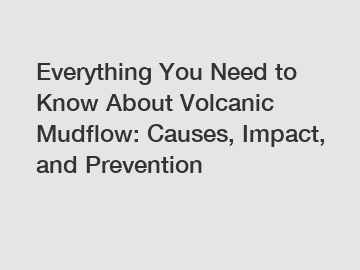Everything You Need to Know About Volcanic Mudflow: Causes, Impact, and Prevention
Volcanic mudflows, also known as lahars, are a natural disaster phenomenon that can have devastating effects on both the environment and communities living near active volcanoes. In this blog post, we will explore everything you need to know about volcanic mudflows – from their causes and impact to prevention and mitigation strategies.
Causes of Volcanic Mudflows.
Volcanic mudflows are primarily caused by the eruption of a volcano, which can trigger the rapid melting of snow and ice on the summit of the volcano. This meltwater mixes with ash, rocks, and other volcanic debris to form a fast-moving slurry that flows down the slopes of the volcano. This mixture of water and volcanic material is what gives volcanic mudflows their unique characteristics and destructive power.

In addition to volcanic eruptions, other factors such as heavy rainfall, earthquakes, or volcanic activity under a glacier can also trigger lahars. These secondary triggers can increase the volume and speed of the mudflow, making them even more dangerous and difficult to predict.
Impact of Volcanic Mudflows.
The impact of volcanic mudflows can be catastrophic, with the potential to cause widespread destruction and loss of life. The fast-moving nature of lahars makes them particularly dangerous, as they can flow at speeds of up to 50 miles per hour and reach distances of tens of miles from the volcano.
Mudflows can bury homes, infrastructure, and agricultural land, leading to economic losses and displacement of communities. They can also block rivers and streams, leading to flooding and further destruction downstream. In addition, the hot temperatures of the volcanic material in the mudflow can pose a significant risk to anyone caught in its path.
Prevention and Mitigation Strategies.
Additional reading:Does Costa Rica have mud baths?
Uncover Volcanic Mud Crossword Clue: Solve the Puzzle Now!
Why Sulfate-Free Products are Essential for Healthy Hair?
Bentonite: The Secret Weapon for Clear Skin?
Unlock the Benefits of Fibrolite Powder in Bulk – Your Ultimate Guide
The Power of White Carbon Black in Agriculture
Which oxide pigment powder is best for?
Preventing volcanic mudflows is a challenging task due to the unpredictable nature of volcanic eruptions and the complex interaction of factors that can trigger lahars. However, there are several strategies that can help reduce the risk and impact of these natural disasters.
One of the most effective ways to prevent volcanic mudflows is to monitor volcanic activity and early warning systems. By monitoring seismic activity, gas emissions, and other indicators of an impending eruption, scientists can provide timely warnings to at-risk communities and help them evacuate to safety.
In addition to monitoring, physical barriers such as levees and dams can be built to contain mudflows and divert them away from populated areas. These structures can help reduce the impact of lahars and protect communities living near active volcanoes.
Land use planning and zoning regulations can also play a crucial role in reducing the risk of volcanic mudflows. By restricting development in high-risk areas and promoting sustainable land management practices, governments can help mitigate the impact of mudflows and protect vulnerable communities.
Finally, education and awareness campaigns can help communities better prepare for volcanic mudflows and respond effectively in the event of an eruption. By teaching residents about the risks and warning signs of lahars, we can empower them to take action and stay safe during a volcanic disaster.
Conclusion.
In conclusion, volcanic mudflows are a natural disaster that can have devastating effects on communities living near active volcanoes. By understanding the causes, impact, and prevention strategies of these natural phenomena, we can better prepare for and mitigate the risk of volcanic mudflows. Through a combination of monitoring, infrastructure development, land use planning, and education, we can work together to protect vulnerable communities and reduce the impact of lahars on both people and the environment.
For more information, please visit yellow calcium bentonite price, Volcanic Rock Stone Provider China, sillimanite powder.
Additional reading:Everything You Need to Know About Cast Steel Balls: Benefits, Uses & Types
Gold Plated Brass vs Gold Plated Stainless Steel - Sky Austria
Why Choose Electropolished Stainless Steel Tubing?
10 Questions You Should Know about Grinding Steel Balls
Hurricane Window Screens vs Perforated Gutter Guards: A Detailed Comparison
What Is Mica Powder? Ethical and Sustainability Concerns
What are the Pros and Cons of Titanium? | OneMonroe
Previous: Does Costa Rica have mud baths?
Next: None
If you are interested in sending in a Guest Blogger Submission,welcome to write for us!




Comments
0